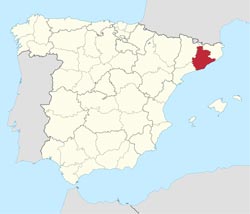Barcelona in Barcelona

Barcelona is a a maritime province of north-eastern Spain, formed in 1833 out of districts belonging to the ancient kingdom of Catalonia, and bounded on the N.E. and E. by Gerona; S. by the Mediterranean Sea; S.W. by Tarragona; and W. and N.W. by Lérida. . Its area is 7,726 km2 (2,983 sq mi). 5,609,350 people live in the province, of whom about 30% (1,620,343) live within the administrative limits of the city of Barcelona, which itself is contained in the Barcelona metropolitan area.
 The capital of the province is the city of Barcelona, and the provincial council is based in the Casa Serra on the Rambla de Catalunya in that city. Some other cities and towns in Barcelona province include L'Hospitalet de Llobregat, Badalona, Cerdanyola del Vallès, Martorell, Mataró, Granollers, Sabadell, Terrassa, Sitges, Igualada, Vic, Manresa, Berga.
The capital of the province is the city of Barcelona, and the provincial council is based in the Casa Serra on the Rambla de Catalunya in that city. Some other cities and towns in Barcelona province include L'Hospitalet de Llobregat, Badalona, Cerdanyola del Vallès, Martorell, Mataró, Granollers, Sabadell, Terrassa, Sitges, Igualada, Vic, Manresa, Berga.
Apart from a few tracts of level country along the coast and near Igualada, Manresa, Sabadell and Vich, almost the whole surface consists of mountain ranges, often densely wooded, rich in minerals and intersected by deep ravines. These ranges are outliers of the Pyrenees, which extend along the northern frontier, forming there the lofty Sierra del Cadi with the peak of Tosa (8317 ft.).
The Catalan Pre-Coastal Range and Catalan Coastal Range mountains run through the Province of Barcelona. There are several notable smaller mountain ranges that are located in the province, including Montseny Massif, Serra de Collserola, and Tibidabo. Pedraforca is the tallest mountain in the province, located on the north side as part of the Pre-Pyrenees. Tibidabo is the mountain that overlooks the city of Barcelona.
Towards the sea, the altitudes become gradually less, although not with a uniform decrease; for several isolated peaks and minor ranges such as Montserrat and Monseny rise conspicuously amid the lower summits to a height of 4000-6000 ft. The central districts are watered by the Llobrégat, which rises at the base of the Sierra del Cadi, and flows into the sea near Barcelona, the capital, after receiving many small tributaries. The river Ter crosses the eastern extremity of the province.
Barcelona can be divided into three climatic zones; a temperate one near the sea, where even palm and orange trees grow; a colder one in the valleys and plains, more inland; and a colder still among the mountains, where not a few peaks are snow-clad for a great part of the year.
Agriculture and stock-keeping are comparatively unimportant in this province, which is the centre of Spanish industry and commerce. In every direction the country looks like a veritable hive of human activity and enterprise, every town and village full of factories, and alive with the din of machinery. Lead, zinc, lignite, coal and salt are worked, and there are numerous mineral springs; but the prosperity of the province chiefly depends on its transit trade and manufacturers.
The Roman Castrum Bergium, on the Llobrégat, is the home of the Catalonian cotton industry. None of the rivers are navigable, and the roads are in general indifferent and insufficient. The province is better off in regard to railways, of which there are 349 m. Important lines radiate from the city of Barcelona north-east along the coast to Gerona and to Perpignan in France; south-west along the coast to Tarragona and Valencia; and west to Saragossa and Madrid. Several local railways link together the principal towns. The population is greater and increases more rapidly than that of any other Spanish province, a fact due not to any large excess of births over deaths, but to the industrial life which attracts many immigrants. In the last quarter of the 19th century the increase exceeded 200,000, while the average yearly number of emigrants was below 2000. In point of education this province is quite among the first in Spain, and as far back as 1880 there were 97,077 children enrolled on the school registers; the figures have since steadily increased.


